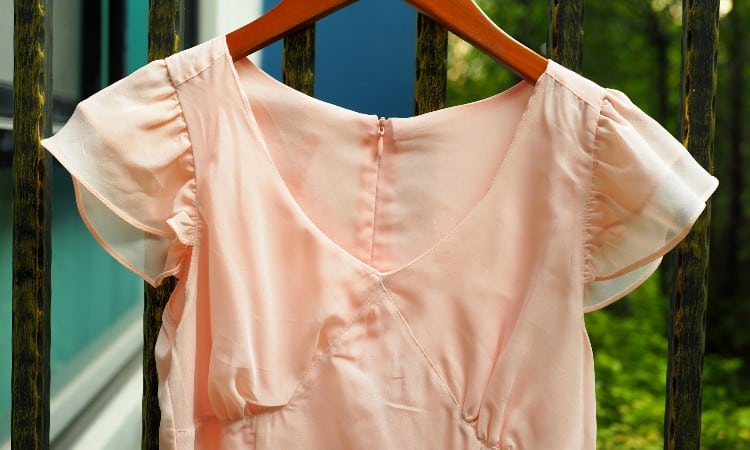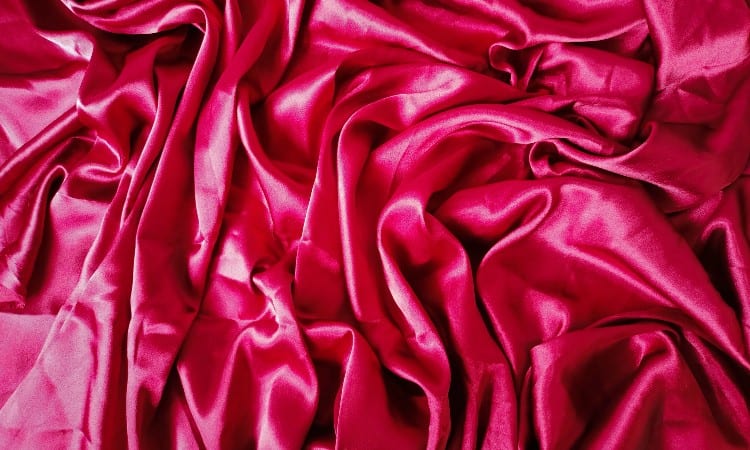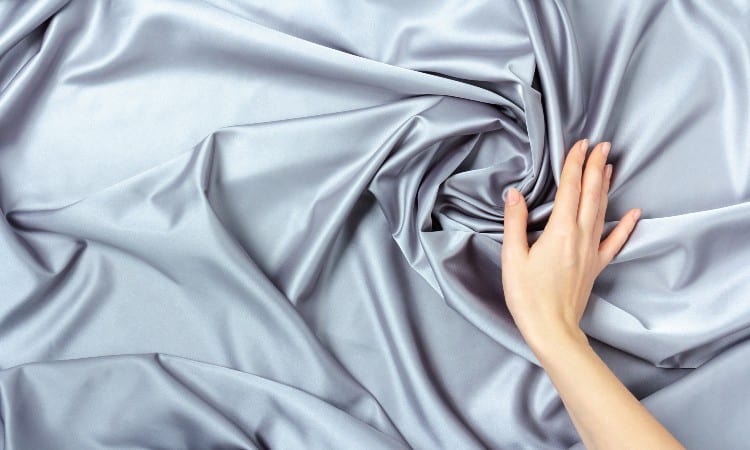To me, satin and silk are very similar materials. They are both soft and shiny and portray an element of luxury. It can be tricky to choose between the two. When it comes to satin vs silk, what is the difference? Which is better?
The main difference is silk is a fiber and satin is a weave. Originally from China, silk is a durable natural material. It’s made from silkworm cocoons and is known for its opulence. A satin weave is normally made from synthetic fiber. Unlike silk, satin is only shiny on one side.
Although satin and silk can be used for the same things, they have different properties. Let’s compare the differences between satin vs silk. Read on to discover which is better for your project.

Satin vs Silk: Key Points
Silk and satin have a lot in common. In fact, it can be easy to think of the terms as interchangeable. The truth is, the two terms refer to completely different things. Silk is a natural fiber derived from silkworms and satin is the name of a specific weave.
The similarities between the two are probably down to the close historical links. Traditionally, satin would have been made from silk fibers. So it’s easy to see why these two terms can become confusing.
These days a satin weave is more likely to be either nylon or polyester. Both are man-made silk imitations. As they both look and feel almost identical to silk, it can be tricky to tell a satin weave from pure silk fabric.
Let’s take a look at some of the characteristics of silk fibers and a satin weave. This table gives a brief overview of each property. We’ll look at each one in detail later in the article.
| Characteristic | Satin | Silk |
|---|---|---|
| Allergies | Hypoallergenic | Hypoallergenic |
| Breathability | Only breathable if made from silk | Very breathable |
| Care and Maintenance | Recommended for dry clean or hand wash only Delicate care | Wrinkles easily and can stretch or shrink when wet |
| Cost | Synthetic versions are cheaper than Silk | Expensive |
| Durability | Easily damaged | Strong and durable |
| Texture | Smooth with a shiny surface on one side, dull on the other | Smooth, soft, luxurious shiny on both sides |
| Type of Fiber | It’s a weave can be polyester, nylon or silk | Natural fiber from silkworms |
| Uses | Sheets, lingerie, hats, evening wear, wedding dresses, ties | Lingerie, ties, eveningwear, parachutes, curtains, sheets |
What Is Silk?

Silk is a natural fiber produced from the cocoons of silkworms. Not only is it one of the oldest fibers in the world, but it’s also one of the strongest. The fibers can be used for items as diverse as lingerie and parachutes.
Originally from China, silk has been produced for close to 12,000 years. Over time, it became popular throughout the world. It was exported through Asia to Europe via the infamous Silk Road, one of the world’s most famous trade routes.
Incredibly popular with royalty and nobility, silk became the fabric of choice due to its luxuriant feel and opulent appearance. It became synonymous with wealth as only the rich could afford to purchase it.
Although China is still the world’s largest silk producer, silk is also made in India, Thailand, and Uzbekistan. The most popular form of silk is Mulberry silk.
Around 95% of the world’s silk is Mulberry as it is the cheapest and easiest to manufacture. In Latin, a silkworm is known as Bombyx Mori, which translates to “silkworm of the mulberry tree”.
Considered sustainable as it’s a natural fiber, silk production has a sad downside. To create the continuous filaments that make up a silk fiber, the silk cocoons have to be unraveled. As an emerging moth would destroy the cocoon, silkworms aren’t allowed to reach the moth stage.
Harvesting silk kills the developing pupa in most cases, making silk one of the least animal-friendly natural fibers available.
An exception to that is the production of Eri silk, also known as peace silk or caster silk. This silk forms staple fibers rather than continuous filaments, so cocoons don’t need to be unraveled in the same way. The resulting fabric is courser though, so very little Eri silk is produced worldwide.
Pros
- Very smooth, soft, and luxurious
- Attractive shine with a subtle rainbow-like hue
- Breathable
- Less likely to cause chafing
- Strong and durable
Cons
- Expensive
- Kills the silkworm in most cases
- Can damage easily when wet
How Is Silk Made?
 The process of making silk is known as silk farming or sericulture. It covers all the life stages of the silkworm, from the egg through to the adult moth.
The process of making silk is known as silk farming or sericulture. It covers all the life stages of the silkworm, from the egg through to the adult moth.
A silkworm can lay around 500 eggs which are about the size of a poppy seed. The eggs are incubated at approximately 25º celsius for 12 days. After hatching, the silkworm larvae look like little black caterpillars. Once they shed their hairy outer coating, they turn white.
Silkworms munch their way through a diet of fresh leaves from mulberry trees throughout the growing phase. As the silkworm grows, it sheds its skin. Producers of silk know silkworms molt four times before they are ready to go into the cocoon phase.
Once a silkworm stops eating and starts looking for somewhere to spin a cocoon, it is transferred to a montage. This is a small frame with little compartments, a bit like a honeycomb. Each worm is given its own little cubby hole where it can spin in peace.
After a week, the cocoons are boiled to soften the silk fibers and the silk is deflossed to remove any loose debris. The cocoons are then reeled. This is the process that unravels the silk and combines multiple filaments into one strand of silk fiber.
The resulting yarn is twisted as it’s formed into skeins. More twists are used to add more silk fibers depending on the grade of silk being manufactured. Once the yarn is twisted, it can be dyed.
Finally, the silk yarn is woven into fabric. A popular weave for silk is charmeuse, which is very similar to satin. Other weaves include chiffon, twill, crepe, and habotai. Each weave creates a different texture and feel.
What Is Satin?

Normally, the name we give to a fabric refers to the type of fiber it contains. That isn’t the case with satin. This time, the name satin is the type of weave.
A satin weave creates a 4:1 ratio warp-faced fabric. This means the warp thread, or the vertical thread, is the most prominent. Satin has a one-over-four-under pattern. Four weft threads go under one warp thread, giving it a shiny topside and duller finish underneath.
Developed in China, the satin weave became popular across Europe in the 12th Century. It was a firm favorite with royalty due to its reputation of being decadent and expensive. Its appearance was down to the fiber it contained. Traditionally, satin was made from silk.
Due to the expense of silk, modern-day satin tends to be made from synthetic fibers. Both nylon and polyester can be woven into a satin weave, creating a cheaper silk substitute. Because of this, most people today consider satin to be a man-made fabric.
Satin’s reliance on polyester and nylon has altered the properties of the weave slightly. Although silk-based satin has breathability and a soft, warm feel, synthetic satin is very different. The nature of the manmade fibers gives satin a cooler, flatter, and more artificial feel.
Pros
- Luxuriant texture
- Resistant to mildew and dust mites
- Less prone to friction
- Cheaper than silk
Cons
- Damages easily
- Not breathable if made from synthetic fiber
- Can feel cold and artificial
How Is Satin Made?
As a weave, satin can be made from silk or synthetic fibers like polyester and nylon. The production of silk-based satins starts with developing the silkworm from the egg to the cocoon phase.
Synthetic satin begins with the manufacture of artificial fibers. These fibers are known as filament fibers. This means they are an indefinite length already and don’t need to be spun to make them longer.
Satin is a 4:1 ratio weave similar to twill. Normally, this weave is 4 weft threads under 1 warp thread. The combination of warp and weft threads in the weave is what creates the silky smooth appearance of the satin fabric.
Variations in the weave ratio alter the look and feel of the resulting material. It will also change the density or thread count of the fabric and its thickness.
Satin vs. Silk: Which Is Better?
 Asking which is better between satin and silk is a little like comparing apples to oranges. Although they are the same in that they describe fabric, they are slightly different. Satin is a weave of the fabric. Silk is a fiber that can be used to make a satin weave. What we need to do is rethink the question.
Asking which is better between satin and silk is a little like comparing apples to oranges. Although they are the same in that they describe fabric, they are slightly different. Satin is a weave of the fabric. Silk is a fiber that can be used to make a satin weave. What we need to do is rethink the question.
Normally, the characteristics of any particular weave are the result of the fiber it contains. A fabric weave can enhance those properties depending on the thickness and type of weave. But, a weave cannot, in and of itself, create the properties of a specific fiber.
For instance, silk is a natural fiber and is breathable. Polyester is a synthetic fiber, so it can’t breathe. A satin weave made from polyester will behave differently from one made of silk. So, the question we should be asking is, is silk better than synthetic-based satin?
These days a satin weave tends to be either polyester or nylon. Based on that, we’ll be pitting natural silk fabric against a manmade satin to see which fairs better in the following characteristics.
Durability
Although silk is a fragile fabric, the fiber it’s made from is incredibly strong and durable. Silk can be used to make several different weaves. These can range from fine and lightweight to densely woven and lightweight. The thicker the weave, the more durable the fabric.
Not only is satin a high maintenance material, but it also isn’t particularly durable. The slightest knock against a rough surface can cause damage. It pills and snags at the drop of a hat.
Of the two, silk is the better option when you need a floaty drape and durability. It wins this category, hands down.
Breathability
Synthetic fibers are unable to breathe. As they are oil-based, they can have an artificial, plastic-like feel, which cannot react and adapt to climate conditions. Satin woven from a manmade fiber will be unable to wick away moisture or keep you cool.
Silk, on the other hand, is derived from the silkworm and is completely natural. With both the ability to regulate body temperature and remove moisture, it keeps you feeling fresh and cool. This is a win for silk.
Allergies
Silk is coated with a natural substance called sericin. Sericin is designed to protect the silkworm while it’s inside the cocoon. The same properties also provide us with protection from fungus, dust mites, and mold. Silk is one of the most allergen-resistant natural fibers on the planet.
Satin, whether it’s made from silk or synthetic fibers, has a built-in resistance to mold, dust, and mildew. Synthetic fabrics are manmade and not as susceptible to attack from allergens. Being essentially plastic, there is nowhere for the dust or mold to seep into the fabric.
There is little to choose between either satin or silk for this category. Both silk and satin are incredibly hypoallergenic. This is an area they both score high marks for.
Care and Maintenance
Satin can be a hard fabric to care for. It can snag and pill easily and requires a delicate hand. It frays easily and is notoriously difficult to sew with. Due to its delicate nature, the fabric is nearly always dry clean only. This fabric is high maintenance.
Silk is a delicate fabric but can be easier to manage. It’s dry cleanable and, depending on the weave, can be washed with care. Although some silk fabrics can be damaged by washing, a gentle hand wash with a line dry can help reduce the chances of stretching, shrinking, or tears. The key with silk is a delicate touch and low or no heat.
With both fabrics requiring a light touch, they are almost equally matched when it comes to care. However, the balance tips just slightly towards silk due to some varieties being washable.
Cost
As a fabric, silk has been expensive for generations. Originally a fabric only the wealthy could afford, its reputation as a luxury item has only grown over the years. Silk production hasn’t changed much and it’s still an expensive process. Due to the nurturing of silkworms and the labor-intensive harvesting, it isn’t cheap to produce silk.
Synthetic satin, on the other hand, can be relatively cheap to produce. Costs involved in the manufacture of polyester and nylon are a lot lower than silk. This helps keep the price of synthetic fibers low and affordable.
For this category, the clear winner is synthetic satin. It may imitate the look, feel, and luxuriant nature of silk, but it doesn’t mimic the price.
Uses
There isn’t much to choose from when it comes to use. Satin and silk are both used for apparel. They give a decadent touch to lingerie. Sheets made from either silk or satin add a touch of elegance to a bedroom. Ties, evening gowns, and curtains look and feel as opulent in silk as they do in satin.
Based on use alone, the weave and the fiber are evenly placed for popularity and give an identical result. For this category, the contest between satin vs silk is a draw.
Should You Buy Satin or Silk?
 Whether you decide to go with satin or silk is down to your personal preference. As both have more in common than not, the choice between the two is probably more likely to be based on budget. You’ll find a synthetic satin is easier on your finances.
Whether you decide to go with satin or silk is down to your personal preference. As both have more in common than not, the choice between the two is probably more likely to be based on budget. You’ll find a synthetic satin is easier on your finances.
Satin’s high maintenance nature might make it more expensive in the long run. Overly delicate and prone to damage, it may not last long. You could be replacing it more frequently than you wanted to. Silk may be more expensive to buy but is more likely to withstand regular use.
The key to working out which one you should buy is down to your project needs. If you need more durability, go with silk. If you want the look of silk but not the cost, go with synthetic satin.
Best Silk Product
LilySilk Silk Fitted Sheet
No products found.Made from 100% mulberry silk fabric, the No products found. comes in several sizes and shades to better suit your bedroom. Creating a feeling of opulent decadence and sophistication.With a beautiful silk sheen, this sheet will be soft and gentle on your skin. Hypoallergenic and breathable, this sheet will keep you comfortable at night.
With the ability to regulate your temperature, you will not be too hot or too cold.
Best Satin Product
WavvelUziz Satin Sheet
 This 100% polyester satin sheet set is wrinkle, fade, and stain-resistant.
This 100% polyester satin sheet set is wrinkle, fade, and stain-resistant.
An ideal choice for adding a dash of elegance to your bedroom.
The set includes a flat sheet, fitted sheet, and two pillowcases to create a coordinated look that oozes luxury and style.
Conclusion
The difference between satin and silk is what they are. Satin is a weave and silk is a fiber. With so many similarities, neither is better than the other. Which one you choose is up to you and the project you have in mind.
Let me know in the comments if you liked the article. Do you prefer silk over synthetic satin? Which one will you be using in your next project?